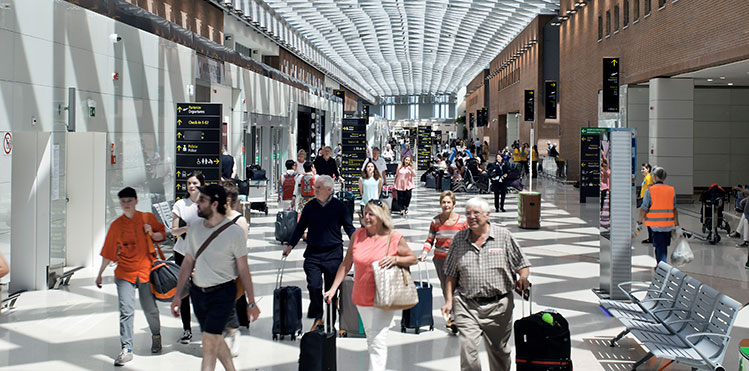
The extension at Venice Marco Polo Airport is defined by a new 280m-long plaza featuring a dramatic gridshell roof that offers a generous and welcoming light-filled space for people departing and arriving at the airport.
On 17 June, One Works completed Phase 1 of a major development plan for Venice Marco Polo Airport, with new facilities carefully integrated into the existing fabric of the airport. Working alongside SAVE Engineering, One Works – a global design and consultancy firm specialising in transport architecture and engineering – has overseen the complex architectural and structural challenges involved in bringing the airport up to 21st century standards. The extension is defined by a new 280m-long plaza featuring a dramatic gridshell roof that offers a generous and welcoming light-filled space for people departing and arriving at the airport.
“The idea was to achieve a ‘suspended’ glass roof that would have sewn up the open space between the curb and the existing terminal buildings – filling ‘lost’ space and turning it into a major feature of the terminal that invites passengers to enter into the airport,” explains Giulio De Carli, Manager Partner and Founder at One Works.
Expanding a passenger terminal is often more complex than building a new one, as it requires a dedicated joint commitment between the airport operator and the design team. “This project was based on a careful programme of works and analysis of different options to ensure the best solution was developed for harmonising the existing structures with new spaces and new generations of plant facilities (such as air-conditioning, lighting, data transmission, etc).”
Currently, the airport is working on the detailed design for Phase 2A of the terminal expansion, which will see an additional 59,000sqm and will include new security facilities, check-in desks, domestic and international gate lounges, boarding bridges, retail areas and food court, new baggage handling system, storage and other support functions. Construction works of this second phase are expected to be completed by 2025.
“The final third phase – Phase 2B – is expected to be completed by 2027, which will see the final configuration of the terminal in line with the overall masterplan and will triple the existing terminal surfaces,” De Carli concludes.







